Rethinking the Commitment: Redesigning Your Engagement Ring
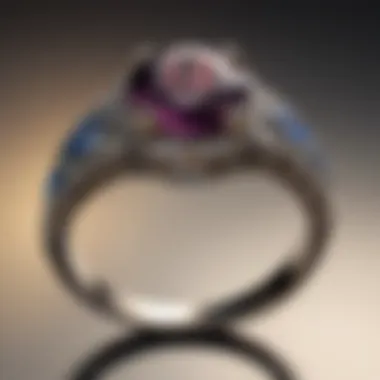
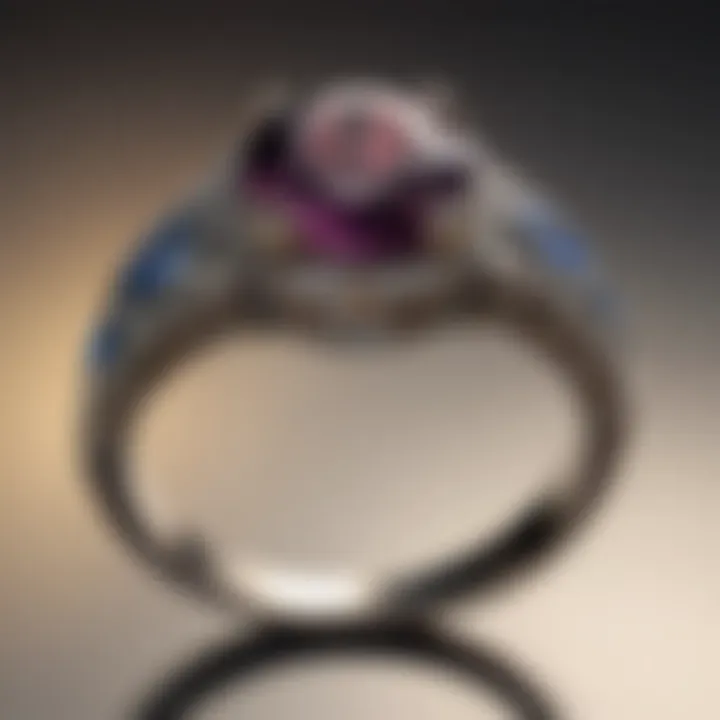
Intro
Redesigning an engagement ring can be a pivotal moment in a relationship. It might signify a journey through life's ups and downs, a celebration of renewed vows, or simply a desire to express personal growth and change. In this guide, we aim to provide a detailed pathway through the process of ring redesign, ensuring that each decision reflects the wearer's unique identity and sentiment.
As individuals grow and evolve, so too can their tastes and dreams. An engagement ring, often viewed as a symbol of unbreakable bonds, can also transform to mirror these changes. This guide will explore various facets of redesign—from understanding the emotional impetus to choosing the right gemstone and style.
In the world of engagement rings, the gemstone at the heart of the design plays a crucial role. It isn’t just a piece of jewelry; it’s a reflection of personality, aspirations, and stories.
Gemstone Overview
Understanding gemstones is essential when thinking about redesigning the centerpiece of an engagement ring. Here, we’ll delve into their definitions, origins, and historical significance to provide a richer context for your selection.
Definition and Origins
A gemstone can be defined as a precious or semi-precious mineral that has been cut and polished for use in jewelry. Gemstones can include diamonds, sapphires, emeralds, and even lesser-known stones like morganite and tanzanite.
Many gemstones originate from deep within the Earth. Formed through intricate geological processes, they come to be under varying conditions of temperature and pressure. This natural creation is nothing short of incredible, making each stone a unique entity.
Historical Significance
Historically, gemstones have played significant roles in various cultures. The ancient Egyptians revered turquoise, believing it provided protection and health. In contrast, the Romans often associated specific gems with certain deities, infusing their jewelry with spiritual significance.
Gemstones have been symbols of wealth, power, and love throughout time. For instance, diamonds are frequently linked with eternal love, making them a popular choice for engagement rings. Their enduring strength serves as a metaphor for the bond between partners.
Gemstone Properties
Beyond mere aesthetics, the properties of gemstones can significantly influence one’s choice when redesigning an engagement ring.
Hardness and Durability
The hardness of a gemstone is often measured on the Mohs scale, which ranges from 1 (talc) to 10 (diamond).
- Diamond: Hardness of 10, making it the toughest on the scale—ideal for daily wear.
- Sapphire: Comes in at 9; excellent choice for both durability and color variety.
- Emerald: Lower on the scale at 7.5 to 8, known for its vivid green but requires extra care.
Understanding these properties ensures the ring not only looks beautiful but can withstand the test of time.
Color and Clarity
The color and clarity of gemstones are pivotal in their valuation and appeal. Each stone has its own palette of colors, and some are only prized when those colors are vivid and vivid and rich. Clarity, on the other hand, refers to the presence of internal or external flaws, often known as inclusions.
"In the world of gemstones, clarity isn’t just about blemish-free beauty; it can also denote uniqueness. Each inclusion can unveil a stone’s story, its journey through time."
Potential buyers should consider these factors as they represent not only the aesthetic pleasure but also the emotional resonance of the ring.
By understanding the rich tapestry surrounding gemstones, individuals can embody their personal stories within their redesigned engagement rings. Keep these insights at the forefront as we journey through further aspects of the redesign process.
The Significance of Redesigning an Engagement Ring
Redesigning an engagement ring isn't merely about aesthetics. It reflects a deeper transformation within a relationship and symbolizes the evolving identity of the individual wearing it. There are numerous reasons someone may seek to redesign their ring, ranging from personal style evolution or changes in relationship dynamics to simply a desire for renewal. The act of reimagining such an important piece of jewelry can serve as a pivotal moment, encapsulating fresh commitments and intentions.
Understanding Personal Motivations
Every individual has unique motivations for considering a redesign. First and foremost, personal taste can significantly shift over time. What may have seemed perfect at one stage of life can come to feel less representative of one’s current self or style. This can be particularly true after major life events, such as the arrival of children, career changes, or even just an evolution in personal interests. It's crucial to take a step back and assess these feelings, which can guide the redesign process.
Perhaps someone inherited a ring that carries emotional weight but isn't quite their taste. On the flip side, they might want to keep the existing stones but revamp the setting in a way that feels more ‘them.’ Recognizing these motivations creates a foundation for a thoughtful approach to the redesign, transforming the ring from just a symbol of commitment to a genuine reflection of personal identity.
Key Points to Consider
- Changes in personal taste may affect how one views their engagement ring.
- Emotional connections to a piece can inspire redesigns while still honoring the original intention.
In the end, participants in this journey often find renewed joy, excitement, or even confidence as they reconnect with the significance of their ring, using it to express who they are today.
Symbolic Meaning of Redesign
The redesign of an engagement ring often transcends mere aesthetic appeal; it represents a significant re-evaluation of the underlying sentiments tied to it. For many, the initial ring symbolizes a promise and a partnership, while the redesigned version can speak to growth, change, and even second chances.
This idea can be compared to the act of painting over a canvas rather than creating a new one. Each layer tells a story. The act of redesigning can breathe new life into what might feel sentimental yet stale, reminding both the wearer and their partner of the journey they’ve been on together. It highlights resilience, strength, and the beauty of evolving love.
Regard the notion of a fresh start—whether it’s moving past a rough patch or celebrating a milestone. A redesigned ring can serve as a testament to overcoming challenges and embracing new beginnings.
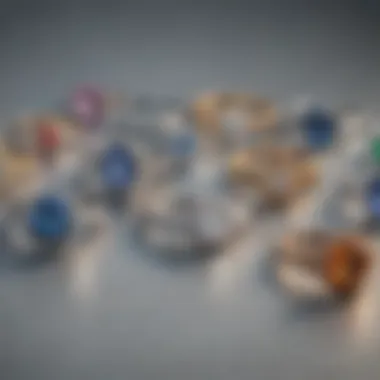
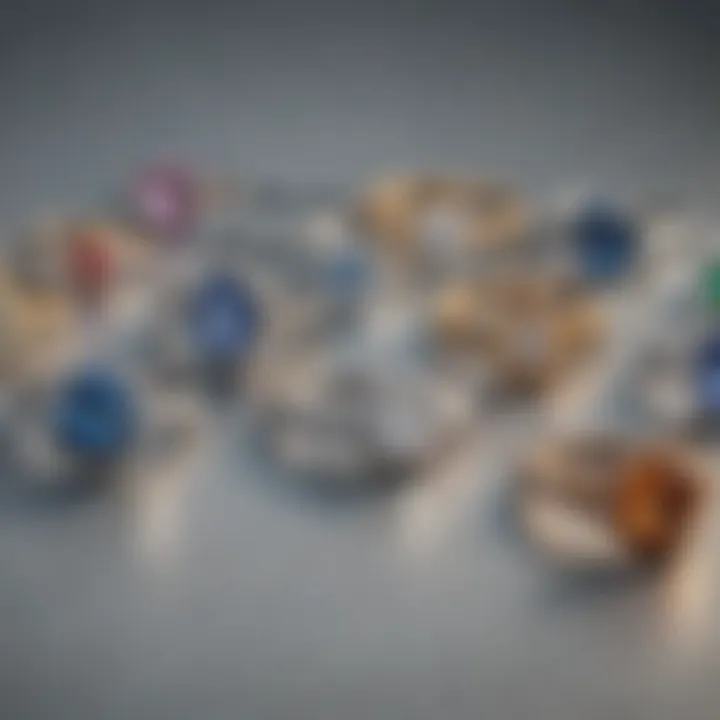
"A redesigned engagement ring can symbolize not just love and commitment, but also the growth and resilience of the individuals within the relationship."
Ultimately, the significance of redesigning an engagement ring lies in its ability to capture an evolving narrative, providing a canvas for continued expression and commitment.
Initial Considerations Before Redesigning
Before you dive headfirst into the journey of redesigning an engagement ring, it’s crucial to take a moment and reflect. The act of redesigning a ring isn’t just about aesthetics; it can represent a profound change—symbolic of your experiences and evolving relationship dynamics. This section navigates the foundational aspects to contemplate prior to embarking on this transformative endeavor.
Assessing the Current Ring
First off, the original ring deserves its day in the sun. Sit down with that piece of jewelry and really assess it. Is it a family heirloom that carries significant emotional weight? Maybe it’s a symbol of a prior relationship, or perhaps it simply no longer resonates with your current self. Look closely for wear and tear—does it bear scratches, or does the setting seem outdated? Taking note of the details can spark ideas on what to keep or modify. You might find that certain elements resonate more deeply than you thought. For example, if the diamonds have a unique cut, they could be repurposed in a new design, creating a bridge between the past and future.
Budgetary Constraints
Once you’ve evaluated the current ring, it’s high time to discuss the elephant in the room—budget. Let’s face it, the costs can add up quicker than a coffee order on a Monday morning. Setting a realistic budget not only helps in narrowing down choices but also prevents surprises down the line. Think about how much you’re willing to push the envelope without breaking the bank. Consider investigating different materials. For instance, opting for a lab-grown diamond can offer a more wallet-friendly alternative while still giving that loved one something uniquely beautiful.
Here are some tips for budgeting effectively:
- Prioritize: Make a list of what’s most important— is it the stone, the setting, or both?
- Research: Look into materials and designs similar to what you envision to gauge cost.
- Consult Experts: Don’t shy away from having open conversations with jewelers about what you can realistically achieve within your budget.
Setting a clear budget will pave the way for a smoother redesign process, allowing you to channel your creativity without financial dread hanging over your head.
Collaboration with Jewelry Designers
When embarking on the journey of redesigning an engagement ring, finding the right jewelry designer can make all the difference. While it might seem like a simple task of picking a talented artisan, the reality is that this collaboration involves a blend of creativity, personal vision, and technical skill. This section delves into why choosing the right designer is crucial and how effective communication can lead to a ring that not only embodies one's style but also carries profound sentimental value.
Finding the Right Designer
Selecting the appropriate designer isn’t just about their portfolio; it's about aligning your aesthetic preferences and emotional needs with their skills. As you begin searching for a jewelry designer, consider the following:
- Research and Referrals: Check online reviews, explore their social media, and perhaps even ask friends or family for recommendations. Jewelers often showcase their work on platforms like Instagram, which can give you insights into their style and capabilities.
- Style Compatibility: Different designers have distinct styles. Whether you’re drawn to vintage elegance or modern minimalism, find a designer whose previous work resonates with you. Look for pieces that feel like they speak your language.
- Experience with Redesigns: Not all jewelers specialize in redesigning pieces. Some may focus on custom creations using new materials. Ensure your chosen designer has experience specifically in remaking or updating existing rings.
- Consultation Approach: During your initial meetings, gauge how they approach your ideas. A good designer should be open and responsive, taking your input seriously while also offering valuable insights.
As the saying goes, "You can't put a price on good design." Though budgets can influence decisions, the value of a skilled designer often outweighs the cost. Investing in expertise helps ensure the essence of the original ring is maintained while creating something entirely new.
Communicating Ideas and Concepts
Collaboration with a designer hinges on effective communication. It’s essential to express your vision clearly and ensure mutual understanding. Here are some techniques to enhance this dialogue:
- Visual Inspiration: Before meeting with your designer, gather images of rings and styles that resonate with you. Create a mood board—whether digital or physical—to visually communicate your desires. This can include color palettes, settings, and even shapes.
- Clear Descriptions: When discussing what you seek, be specific. If you love the look of a round diamond but want to pair it with a rose gold band, state that clearly. Avoid vague descriptions that could lead to misunderstandings.
- Listen Actively: Your designer will have experience and expertise to offer. Listen to their aesthetic recommendations based on your concept—this collaboration should feel like a dialogue rather than a monologue.
- Adaptability: While having a vision is essential, remain open to the designer’s suggestions. They might propose unique ideas that align with your needs and enhance the final design.
In summary, finding the right designer and ensuring effective communication throughout the redesign process can lead to a ring reflective of both personal history and contemporary style. The piece becomes more than just a piece of jewelry; it evolves into a wearable testament to a journey continually being written.
"A design isn’t just what it looks like and feels like. The design is how it works." - Steve Jobs
Engaging in a meaningful partnership with a jewelry designer moves you gracefully towards creating a piece that’s more than an accessory, but a cherished relic of commitment, love, and personal expression.
Choosing the Right Gemstones
Choosing the right gemstones for your redesigned engagement ring plays a pivotal role in personalizing the piece and infusing it with both beauty and meaning. The stones you select can reflect personal taste, signify important life events, or represent the characteristics you wish to embody in your relationship. Given the emotional weight often attached to engagement rings, finding the perfect stones becomes a journey of self-discovery and thoughtful consideration.
Exploring Popular Gemstone Options
When considering gemstone options for an engagement ring, the variety can be quite overwhelming. While diamonds have long been the traditional choice, numerous alternatives can add unique flair and individuality to the design. Some popular options include:
- Sapphires: Renowned for their vibrant hues, sapphires come in various colors beyond the classic blue. Their hardness and durability make them ideal for daily wear.
- Emeralds: Green and enigmatic, emeralds symbolize rebirth and love, but require careful consideration due to their relative softness.
- Rubies: A symbol of passion, rubies offer stunning red tones and are among the hardest gemstones, blending beauty with resilience.
- Moissanite: Often considered a cost-effective alternative to diamonds, moissanite showcases a brilliance that can rival even the finest diamond, making it an attractive option.
- Colored gemstones: Options like tourmaline, topaz, or garnet allow for personal expression based on your favorite colors or birthstones.
"Selecting a gemstone isn't just about the stone itself; it's about the story it tells."
Understanding Stone Properties
Each gemstone comes with its own set of properties that merit consideration when redesigning your ring. The hardness of a stone, for instance, influences its durability in day-to-day wear. Diamonds score a 10 on the Mohs scale, making them the hardest material available. In contrast, softer stones like opals or pearls can show wear more quickly, which may not suit everyone’s lifestyle.
Other properties to consider include:
- Color: Assess how various hues may align with your personal aesthetic.
- Clarity: The fewer inclusions, the more valuable the stone, though some prefer stones with unique character.
- Cut: The way a stone is cut can enhance its brilliance and visual appeal, dictating how light interacts with it.
Cultural Significance of Gemstones
Gemstones carry different meanings across cultures, often symbolizing love, fidelity, or prosperity. For instance, sapphires are traditionally associated with royalty and have been favored for centuries as a symbol of fidelity and sincerity. In contrast, the emerald’s lush green is linked to fertility and rebirth, making it meaningful for many couples.
Likewise, birthstones can impart personal significance—choosing a stone that aligns with either partner's birth month can symbolize their unique bond and connection. Understanding the deep cultural meanings behind each gemstone can enrich the redesign process, offering a deeper narrative to share with others.
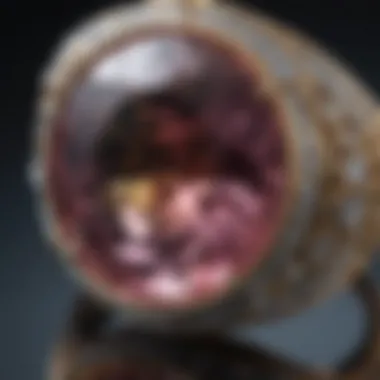
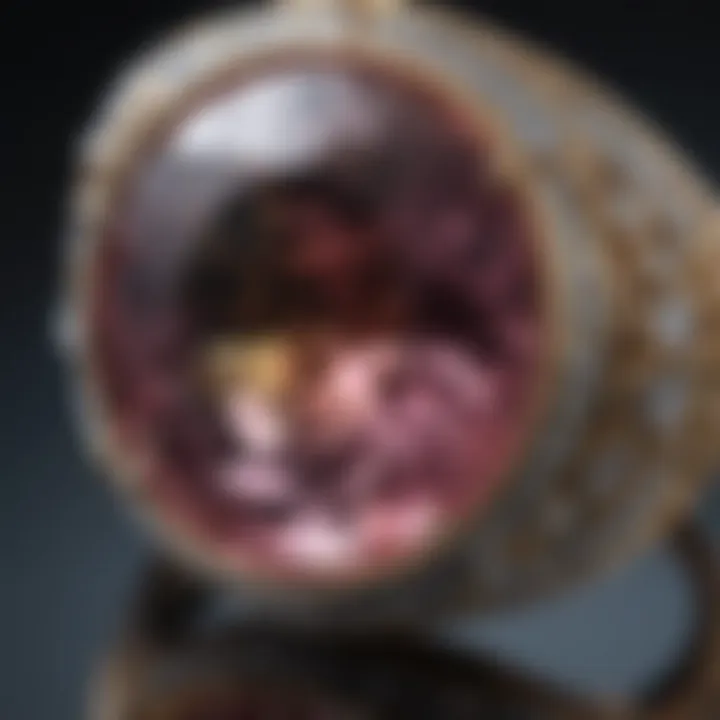
Designing the Ring: Styles and Trends
The act of designing an engagement ring goes beyond mere aesthetics; it touches upon personal identity, emotional ties, and contemporary artistic expressions. As couples or individuals contemplate redesigning their rings, understanding the prevailing styles and trends is paramount in shaping a meaningful symbol.
By diving into the intricate world of ring design, one can appreciate how each choice reflects unique narratives and preferences. Whether you lean toward the glamorous expressive forms of contemporary jewelry or find yourself drawn to the timeless allure of classic engagements, recognizing these categories paves the way for a thoughtful redesign process.
Benefits of Understanding Styles and Trends
- Informed Decisions: Grasping the various styles helps in making educated choices about what resonates.
- Cohesiveness with Personal Style: Selecting a design that harmonizes with one’s personal style can enhance the ring's significance.
- Potential Investment Value: Certain styles might hold their value or even appreciate over time, particularly if associated with prevailing trends.
Let’s look a bit closer at two primary categories of ring designs:
Classic Designs vs. Contemporary Styles
Classic designs have withstood the test of time, often embodying the essence of romance and tradition. These rings often feature conventional settings with solitaire diamonds, intricate lacework, and the use of yellow or white gold. Rings such as these evoke nostalgia and connect to a long lineage of love stories, providing comfort and reassurance to many couples.
On the flip side, contemporary styles embrace creativity and innovation. They push the boundaries of what is considered traditional. Unique shapes like asymmetric designs, colored gemstones, and mixed metals have surged in popularity. For instance, rings showcasing raw diamonds or those designed with geometric patterns appeal to those favoring modern esthetics. People are increasingly open to unconventional materials such as recycled metals or even lab-created stones, reflecting a broader, more inclusive understanding of love and commitment.
In deciding between classic and contemporary styles, couples must weigh their personal beliefs and preferences. Each option comes with its unique set of values: classic may symbolize stability and tradition, while contemporary can represent change and individuality.
Incorporating Personal Touches
Personal touches can turn an already special piece into something downright extraordinary. It’s in those bespoke elements that stories unfold. Whether it’s engraving special dates, using a gemstone with familial significance, or choosing an uncommon band shape, these details elevate a ring from a simple accessory to a cherished narrative.
Some ways to personalize include:
- Custom Engravings: A few words, a significant date, or even a short phrase enhances emotional connections.
- Family Heirlooms: Using stones from inherited pieces tightens the connection between generations, adding layers of sentiment.
- Imagery Inspired by Personal Journeys: Choosing styles or gems that reflect personal milestones—like the birthstone of children or the gem associated with a memorable vacation—captures unforgettable moments.
Ultimately, designing a ring is about expressing a story—yours or your relationship’s. Emphasizing personal elements often leads to a piece that is cherished for decades and passed down through generations.
In navigating the waters of redesigning your engagement ring, understanding styles, and incorporating personal touches is essential. It melds modern trends with cherished memories to create a meaningful symbol tailored uniquely to individual experience and taste. Such a ring doesn't just sparkle; it resonates with history, identity, and love.
Sustainability in Engagement Ring Redesign
The conversation surrounding sustainability in engagement ring redesign has gained significant momentum in recent years. As individuals become more environmentally conscious, they are looking for ways to make choices that not only reflect their personal style but also align with their values. Redesigning an engagement ring with sustainability in mind can usher in a fresh approach to this cherished symbol, fostering a deeper connection with both the jewelry and the planet.
Ethical Sourcing of Materials
A major aspect of sustainable redesign lies in the ethical sourcing of materials. When embarking on this journey, understanding where each component of the ring comes from is crucial. Many jewelers today are committed to sourcing their gemstones and metals responsibly, ensuring that they are not contributing to conflict or environmental degradation. This means looking for certifications or transparent supply chains that confirm ethically sourced stones and recycled or fair-trade metals.
For example, consider a gold ring remade from recycled gold. This not only reduces the need for new mining, which can cause significant harm to ecosystems, but also honors the legacy of the original piece without discarding its value. Seeking out jewelers who focus on sustainability can make a world of difference in the impact your redesigned ring has on the environment.
"Every small step towards sustainability can create ripples of change, impacting both personal connections and the world at large."
Considerations for Vintage and Recycled Pieces
Another exciting avenue to explore in sustainable engagement ring redesign is the utilization of vintage and recycled pieces. Not only does this approach reduce the environmental footprint of new jewelry creation, but it also offers a chance to embrace unique designs that are often one-of-a-kind. Vintage rings can carry their own stories and character, adding a layer of sentimentality to the redesigned piece.
Incorporating elements from these older pieces can create a beautiful melding of past and present. For instance, an heirloom ring can be reconfigured, enhancing its original beauty while ensuring it fits the modern aesthetics of its new owner.
This option also presents an opportunity to explore alternative gemstones and settings that may not be available in mainstream retail. Each choice made during the redesign process has the potential to contribute to a sustainable future, served through conscious decisions.
Ultimately, choosing to prioritize sustainability in engagement ring redesign fosters a shared sense of responsibility for our planet while creating a timeless piece that speaks to one's personal story. As awareness grows, the possibility for creativity and ethical practice in jewelry design expands, resulting in pieces that reflect both individual style and a commitment to bettering the world.
Overcoming Challenges in Redesigning
Redesigning an engagement ring can often feel like navigating a maze filled with emotions, expectations, and memories. It's a process that invites introspection and candor, as the journey to create a new ring involves overcoming significant hurdles. Understanding these challenges is crucial for anyone looking to reconfigure a piece that's so entwined with personal significance.
Emotional Ties to the Original Ring
An engagement ring isn't merely a decorative piece; it represents deep emotional connections and pivotal moments in a relationship. The shimmering diamond or an ornate band often encapsulates memories—like the proposal or the countless days spent dreaming together. When considering a redesign, one must confront the emotional weight that the original ring carries.
For many, the thought of altering or completely reinventing the ring can spark feelings of guilt or anxiety. After all, no one wants to diminish the precious history behind it. A practical step is to acknowledge these emotions upfront. This might involve having candid conversations with your partner about what the ring signifies and how altering it fits into your shared narrative. Keeping a few elements from the original piece can help bridge the connection from the past to the future, making the redesign feel less like a rejection of history and more like an evolution.
In some cases, it may also be advantageous to seek support from a jeweler who understands the sentimental value behind the design. They can offer insights on how to preserve aspects of the original while introducing new features that speak to your current self. Remember, it’s about aligning your past with your present to forge a new future together.
Managing Expectations
Once the emotional layers have been peeled back, the next challenge lies in managing expectations throughout the redesign journey. As anyone knows, expectations can be a double-edged sword. They motivate and inspire, but can also lead to dissatisfaction if the outcome doesn’t align perfectly.
To tackle this, it’s important to set realistic goals from the outset. This involves considering both the aesthetic elements and the budget or timeline you’re working within. For instance, if you're looking to incorporate a specific gemstone or design element that’s particularly trendy, ensure you know about the costs or potential lead times required for such a creation.
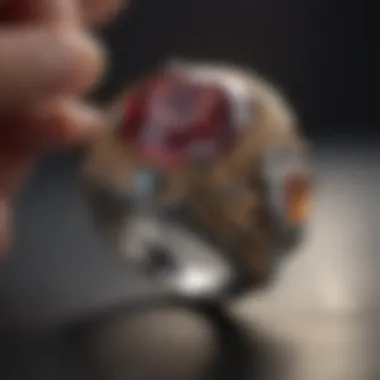
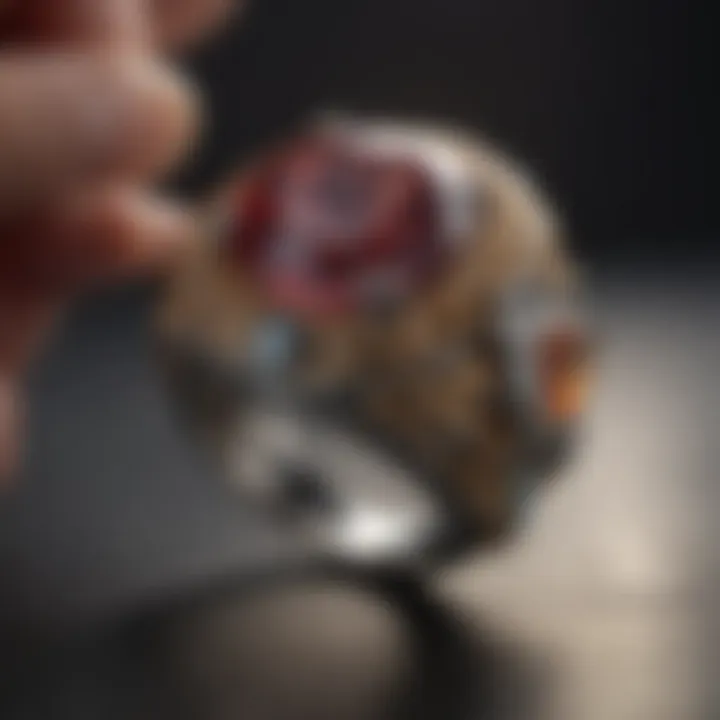
Another effective strategy is to maintain open lines of communication with your jeweler. As this person is tasked with bringing your vision to life, having frequent discussions about progress, challenges, or unexpected alterations can keep both parties aligned. This is also a meaningful opportunity to flex your creativity. Being flexible can often lead to an outcome even more gratifying than what you initially envisioned.
In summary, overcoming challenges in redesigning an engagement ring isn’t only about altering a piece of jewelry; it’s about weaving together the sentimental past and your evolving present. By addressing emotional ties thoughtfully and managing expectations with clarity, you pave the way for a design that truly reflects who you are and the story you wish to tell.
Timelines and Process of Redesigning
Redesigning an engagement ring involves a multifaceted process that requires careful planning and a clear understanding of timelines. The significance of having a well-structured timeline cannot be overstated. It not only helps in managing expectations but also allows both the wearer and the designer to stay aligned throughout the remodeling journey. A thoughtful approach ensures that the final piece not only reflects personal style but also resonates with the sentimental values it represents.
Taking the time to outline the phases of redesign can make the process more manageable and less overwhelming. Let’s delve into the typical stages and considerations that will help streamline the experience of transforming your ring.
Typical Timeframes
Understanding the typical timeframes for redesigning an engagement ring can set the stage for a smoother experience. While timelines can vary greatly based on the scale of the redesign and the specific needs of the wearer, having a general guideline helps immensely.
- Initial Planning: Allow 1-2 weeks for sorting through your ideas and narrowing down your preferences. This phase is crucial; it sets the direction for the redesign.
- Choosing a Designer: Spend around 2-4 weeks researching and consulting with various jewelers. It’s essential to find someone who understands your vision and can create your dream piece.
- Design Development: After selecting your designer, expect the design phase to take between 2-6 weeks. This period may involve multiple sketches and discussions.
- Material Sourcing: Depending on the proximity and availability of materials, you might need an additional 2-4 weeks. This includes selecting gemstones and sourcing precious metals.
- Crafting the Ring: The actual crafting usually takes anywhere from 4-8 weeks. Each piece is unique, and quality craftsmanship demands patience.
In total, a full redesign could take about 3 to 6 months, so plan your timeline accordingly. This flexibility allows for creativity to flourish without rushing any crucial steps.
Staying Organized During the Process
Staying organized during the redesign process is key to minimizing stress and ensuring a successful outcome. There are several strategies to achieve effective organization that can lead to a successful redesign.
- Create a Project Calendar: Mark key dates such as consultations, approvals, and expected completion dates. Having a visual timeline can help keep your thoughts clear.
- Keep a Journal: Document your ideas, sketches, and inspirations in one place. This journal can also serve as a visual reference for discussions with your designer.
- Set a Budget: Outline your budget upfront, and factor in costs for materials, labor, and potential unexpected expenses. This will keep your spending in check and avoid surprises at the end.
- Communicate Regularly: Schedule regular check-ins with your jeweler to update your progress, address any concerns, and ensure you are both on the same page.
"Failing to plan is planning to fail."
Effective organization throughout the redesign process can save you time and heartache. By prioritizing these organizational strategies, you can cultivate a rewarding experience, allowing the emotional significance of the redesign to shine through in every aspect of the final piece.
The Role of Sentimentality in Ring Redesign
Sentimentality plays a vital role in the redesign of engagement rings, intertwining emotional bonds with the art of jewelry making. For many, these rings are not just pieces of jewelry; they are loaded with memories, history, and personal significance. When contemplating a redesign, acknowledging the emotional threads tied to the original piece can create a more profound connection to the revamped ring. The process of redesigning an engagement ring demands a careful consideration of what emotions, stories, and milestones the new creation is meant to embody.
Many people may face the dilemma of wanting to refresh their engagement ring while grappling with the memories it holds. The challenge lies in balancing the desire for a new aesthetic with the cherished past represented by the original design. A successful redesign means the new ring should reflect present aspirations while paying homage to memories of love and commitment. This sentimentality speaks to the heart of why individuals choose to redesign their rings, making it a crucial aspect of the journey.
Inherited Rings and Family Values
When it comes to inherited rings, the sentimental value can be immeasurable. Often passed down through generations, these rings carry the legacy of family traditions and stories. Redesigning an inherited ring presents a unique opportunity to blend contemporary designs with historical elements, thus maintaining the essence of family values while ensuring the piece fits the modern wearer’s style.
One might consider these aspects when redesigning an inherited ring:
- Respect for Tradition: Maintaining recognizable aspects of the original ring can bridge the past with the present, honoring family history.
- Incorporation of Personal Touches: While keeping the ring’s spirit, adding personal elements or modern features can make the piece resonate on an individual level.
- Shared Stories: Using a ring that once belonged to a loved one can instigate conversations, making the redesigned piece a vessel for sharing family narratives within future generations.
Individuals may also find solace in the act of redesigning an inherited ring as a way to celebrate the bond they shared with a beloved family member. This can create a touching and impactful experience that reverberates through family ties.
Creating New Memories with a Redesigned Piece
When a ring undergoes redesign, it opens the door to creating new memories. The freshly designed ring can symbolize a new chapter in the wearer’s life, perhaps marking significant milestones such as anniversaries, personal achievements, or new beginnings. By integrating elements that reflect current tastes, lifestyles, and values, the redesigned ring serves as a unique marker of experiences yet to unfold.
Consider the following when aiming to create new memories with a redesigned engagement ring:
- Focus on the Journey: Each redesigned piece can tell the story of your relationship’s evolution, solidifying its importance in both your past and future.
- Collaborative Creation: Involving your partner or family members in the design process can deepen connections, allowing everyone to invest emotionally in the new creation.
- Milestone Commemoration: Choose design elements that symbolize significant moments in your life together, like incorporating a gemstone that represents a special date or place.
"With every cut and setting, the redesigned engagement ring encapsulates our shared past while paving the way for future memories."
Whether enhancing the original sentiment or minting a new chapter, the emotional significance of redesigning rings cannot be overlooked. Ultimately, the blend of old and new creates a rich tapestry of sentiments that speaks to the heart of the wearer—as well as to the narrative of love itself.
Finalizing the Design: Final Touches and Presentation
As you reach the culmination of the ring redesign process, this stage cannot be underestimated. It involves not just the physical aspects of the redesigned engagement ring but also the emotional significance tied to this newly crafted artifact. Final touches may seem trivial, but they are pivotal in ensuring that the ring encapsulates the essence of what you want it to represent in your relationship. Pay attention to small details, as they can speak volumes about the thought and care put into the redesign.
Reviewing the Final Piece
Before you can proclaim the redesign a success, it's imperative to conduct a thorough review of the final piece. This review is more than just inspecting for scratches or loose settings; it’s an opportunity to scrutinize whether the overall design aligns with your vision. Start by considering the following aspects:
- Aesthetic Integrity: Does the ring reflect the style you had in mind? Whether it be vintage, modern, or something completely unique, ensuring the aesthetics resonate with your initial concept is key.
- Comfort Fit: Try on the ring multiple times, ensuring it sits comfortably on your finger. Sometimes, a design can appear stunning but may not sit well on the hand. Confirming fit will save you a future trip to the jeweler for adjustments.
- Material Quality: Assess the materials used—are they durable enough for your lifestyle? A ring is meant to last, so take a closer look at the integrity of the metal and the sturdiness of the setting.
It might be useful to bring in someone for a second opinion. A fresh set of eyes can catch details you might overlook. Beyond just the design, it might help to have an emotional connection check. Does it evoke the feelings and memories you associate with your relationship?
"A well-designed ring does more than just accessorize; it encapsulates stories, emotions, and milestones."
Creative Ways to Present the Redesigned Ring
Once the design has been finalized, the next step is to think about how to present the ring. Presentation is an art in itself, and it can enhance the emotional impact of the moment. Here are some engaging ways you can do this:
- Personalized Box: Instead of the typical ring box, consider custom packaging. This could mean using a material that holds sentimental value or even engraving a personal message onto it.
- Scavenger Hunt: Elevate the experience with a surprise. You can create a scavenger hunt that leads your partner to the ring. Each clue can evoke memories of your relationship, adding a layer of depth to the moment.
- Memory Book: Compile a small book or a scrapbook with photographs and quotes from milestones in your relationship. Present the ring as the final piece of this personalized collection, strengthening the narrative of your journey together.
- Ceremony of Love: Organize a small, intimate gathering with family and friends to showcase the redesigned ring. This adds layers of community and shared joy in your celebration.
In presenting the ring, consider how you want your partner to feel. The importance lies not just in the ring itself but in how it is introduced into your shared narrative. This is a moment meant to be cherished and celebrated, making your presentation an integral part of the redesign adventure.



